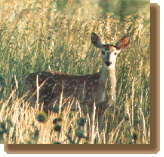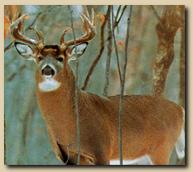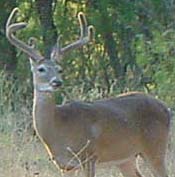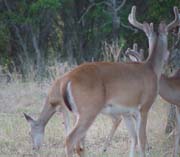
Whitetail Deer

General Information
The whitetail deer or Virginia deer is native to the eastern United States. Its range, however, extends over most of the United States, southern Canada, Mexico, Central America, and northern South America. The whitetail deer is known for its characteristic long tail, which is white underneath. The whitetail deer is one of the largest American deer. The buck, on average, reaches about 6 feet in length and 3 to 4 feet in height at the shoulders. It weighs from 100 to 300 pounds or more. In America today, the whitetail deer is one of the most popular big-game animals hunted. Belonging to the family Cervidae, it is classified as Odocoileus virginianus.

History
The whitetail deer is believed to have migrated to the Unites States approximately 4 million years ago. Over time, the deer population has fluctuated. Regardless of declines in its population, with new technology and innovations the whitetail has become one of the most widespread deer in the world today. North American's whitetail population is estimated at 20 to 25 million deer.

Anatomy
Whitetail deer are ruminant (cud-chewing) animals with four chambered stomachs. When deer feed, they tongue food to the back of their mouths and chew just enough to swallow. After a deer fills its paunch, it lies down to chew its cud. After chewing its cud a while, the deer reswallows the food and it passes in to the second portion of the stomach. After about 16 hours food passes to the third chamber. The fourth chamber produces acid to break down the food pieces for easier absorption of the ingredients. A deer urinates and defecates on average of about 13 times a day.
 Antlers
are a buck's crowning glory. They are composed of bone. It is the
fastest growing tissue, growing and average of 1 to 2 inches per week in the
spring and summer. Velvet covers growing antlers. The velvet
contains blood vessels and nerve ending making them sensitive to the
touch. Once antlers reach full growth and mineralize in late summer.
After the breeding season a new set of antlers begin to grow.
Antlers
are a buck's crowning glory. They are composed of bone. It is the
fastest growing tissue, growing and average of 1 to 2 inches per week in the
spring and summer. Velvet covers growing antlers. The velvet
contains blood vessels and nerve ending making them sensitive to the
touch. Once antlers reach full growth and mineralize in late summer.
After the breeding season a new set of antlers begin to grow.
Deer see best at night. The can see some 310 degrees due to their eyes being set to the side of their head. Their vision is not acute though. In sunlight, a deer's pupils contract into narrow bands. This lets a buck or doe focus across a wide swath of horizon. Deer do not have many of the additional visionary characteristics that humans take for granted. Deer see at a lower resolution which enables us to hide in our camouflage.

The whitetail has a sense of hearing that is crucial. The deer can easily pick up a faint sound and in a split-second determine the approximate distance to the noise. The deer's ears contain many complex muscles that move freely. The ears rotate in all directions to home in sounds.
The main purposes of a deer's coat are camouflage and thermoregulatoin. The process of molting is growing a different coat in summer and winter. No matter the season, deer sport a white throat patch. A fawn is born with reddish brown coat speckled with white spots. This allows a little deer to blend with its surroundings. Summer coats are thin, helping deer cope with the heat., By September, the reddish coat begins to fade to gray and thicken to help keep the deer warm in cold weather and snow. During the rut, some bucks develop dark facial hair.
The life expectancy is 15 t0 20 years, but most only live from 1 1/2 to 2 1/2 because of predators, hunters, disease, and being hit by cars. During the first 14 years of a doe's life, she may have up to 31 fawns--one her first years of maturity and two every year after that.

Habitat and Food
Deer inhabit a small home range of about 1 square mile. In northern states, deer have larger home ranges. Deer adapt very easily. The whitetail deer is a woodland animal, but it is not found in the deep, unbroken forest. It favors the sunny glades where it can feed on leaves, buds, and twigs of woody bushes, as well as grass.

Hyperlinks
White-tailed Deer Whitetails on the Web
NMNH Department of Systematic Biology, Division of Mammals - Mammal Species of the World Home Page